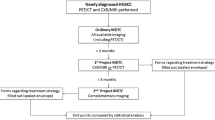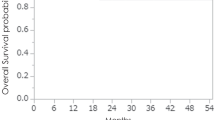Abstract
Aim
To analyze the impact of 18F-fluorodeoxyglucose-PET/CT (PET/CT) in the radiotherapy (RT) planning strategy in HNC, correlating CT-scan and PET/CT performances.
Materials and methods
Inclusion criteria were: age >18 years old, histologically proven head and neck cancer (HNC), patients candidate to definitive RT ± chemotherapy, stage of disease by means of PET/TC and CT-scan performed at our Cancer Care Center.
Results
Sixty patients were analyzed. The following primary tumor sites were investigated: nasopharynx (13%), oropharynx (42%), oral cavity (32%) and larynx non-glottic (13%). Globally, PET/CT findings caused changes on nodal radiation treatment volumes in 10% of all the population of study. Specifically, in 5 cases out of 19 oral cavity tumors (26%), PET/CT detected neck-nodes positive (not detected at CT-scan). These findings have allowed to change the patients management, including PET/CT neck-nodes positive in the high-risk RT volumes.
Conclusion
In the RT planning strategy, the present findings support the use of PET/CT to improve upfront regional staging of HNC disease, particularly for oral cavity tumors. Further investigations are advocated to evaluate if this strategy could impact on long-term outcomes in terms of local control and overall survival.
Similar content being viewed by others
References
Yoo J, Henderson S, Walker-Dilks C (2013) Evidence-based guideline recommendations on the use of positron emission tomography imaging in head and neck cancer. Clin Oncol (R Coll Radiol) 25(4):e33–e66
Mazzola R, Ferrera G, Alongi F et al (2015) Organ sparing and clinical outcome with step-and-shoot IMRT for head and neck cancer: a mono-institutional experience. Radiol Med 120(8):753–758
Wong WL, Ross P, Corcoran M (2013) Evidence-based guideline recommendations on the use of positron emission tomography imaging in head and neck cancer from Ontario and guidelines in general—some observations. Clin Oncol (R Coll Radiol) 25(4):242–245
https://www.nccn.org/store/login/login.aspx?ReturnURL=http://www.nccn.org/professionals/physician_gls/pdf/head-and-neck.pdf. Accessed May 2017
Roh JL, Yeo NK, Kim JS et al (2007) Utility of 2-[18F] fluoro-2-deoxy-d-glucose positron emission tomography and positron emission tomography/computed tomography imaging in the preoperative staging of head and neck squamous cell carcinoma. Oral Oncol 43:887–893
Pohar S, Brown R, Newman N et al (2007) What does PET imaging add to conventional staging of head and neck cancer patients? Int J Radiat Oncol Biol Phys 68:383–387
Hafidh MA, Lacy PD, Hughes JP et al (2006) Evaluation of the impact of addition of PET to CT and MR scanning in the staging of patients with head and neck carcinomas. Eur Arch Otorhinolaryngol 263:853–859
Scott AM, Gunawardana DH, Bartholomeusz D et al (2008) PET changes management and improves prognostic stratification in patients with head and neck cancer: results of a multicenter prospective study. J Nucl Med 49:1593–1600
Lonneux M, Hamoir M, Reychler H et al (2010) Positron emission tomography with [18F] fluorodeoxyglucose improves staging and patient management in patients with head and neck squamous cell carcinoma: a multicenter prospective study. J Clin Oncol 28(7):1190–1195
Connell CA, Corry J, Milner A et al (2007) Clinical impact of, and prognostic stratification by, F-18 FDG PET/CT in head and neck mucosal squamous cell carcinoma. Head Neck 29:986–995
Cacicedo J, Fernandez I, Del Hoyo O et al (2015) Should PET/CT be implemented in the routine imaging work-up of locally advanced head and neck squamous cell carcinoma? A prospective analysis. Eur J Nucl Med Mol Imaging 42(9):1378–1389
Thiagarajan A, Caria N, Schoder H et al (2012) Target volume delineation in oropharyngeal cancer: impact of PET, MRI, and physical examination. Int J Radiat Oncol Biol Phys 83:220–227
Riegel AC, Berson AM, Destian S et al (2006) Variability of gross tumor volume delineation in head-and-neck cancer using CT and PET/CT fusion. Int J Radiat Oncol Biol Phys 65:726–732
Schinagl DA, Vogel WV, Hoffmann AL et al (2007) Comparison of five segmentation tools for 18F-fluoro-deoxy-glucose-positron emission tomography-based target volume definition in head and neck cancer. Int J Radiat Oncol Biol Phys 69:1282–1289
Delouya G, Igidbashian L, Houle A et al (2011) 18F-FDG-PET imaging in radiotherapy tumor volume delineation in treatment of head and neck cancer. Radiother Oncol 101:362–368
Castelijns JA, van den Brekel MW (2002) Imaging of lymphadenopathy in the neck. Eur Radiol 12(4):727–738
Mazzola R, Ricchetti F, Fiorentino A et al (2016) Cachexia induces head and neck changes in locally advanced oropharyngeal carcinoma during definitive cisplatin and image-guided volumetric-modulated arc radiation therapy. Eur J Clin Nutr 70(6):738–742
Mazzola R, Ricchetti F, Fiorentino A et al (2014) Dose-volume related dysphagia after constrictor muscles definition in head and neck cancer intensity-modulated radiation treatment. Br J Radiol 87(1044):20140543
Mazzola R, Ricchetti F, Fersino S et al (2016) Predictors of mucositis in oropharyngeal and oral cavity cancer in patients treated with volumetric modulated radiation treatment: a dose-volume analysis. Head Neck 38(Suppl 1):E815–E819
Paes FM, Singer AD, Checkver AN et al (2013) Perineural spread in head and neck malignancies: clinical significance and evaluation with 18F-FDG PET/CT. Radiographics 33:1717–1736
Ng SH, Chan SC, Yen TC et al (2009) Staging of untreated nasopharyngeal carcinoma with PET/CT: comparison with convencional imaging work-up. Eur J Nucl Med Mol Imaging 36:12–22
Arya S, Rane P, Deshmukh A (2014) Oral cavity squamous cell carcinoma: role of pretreatment imaging and its influence on management. Clin Radiol 69(9):916–930
Ng SH, Yen TC, Chang JT et al (2006) Prospective study of [18F] fluorodeoxyglucose positron emission tomography and computed tomography and magnetic resonance imaging in oral cavity squamous cell carcinoma with palpably negative neck. J Clin Oncol 24:4371
Kim MR, Roh JL, Kim JS et al (2007) Utility of 18F-fluorodeoxyglucose positron emission tomography in the preoperative staging of squamous cell carcinoma of the oropharynx. Eur J Surg Oncol 33(5):633–638
Yoon DY, Hwang HS, Chang SK et al (2009) CT, MR, US,18F-FDG PET/CT, and their combined use for the assessment of cervical lymph node metastases in squamous cell carcinoma of the head and neck. Eur Radiol 19(3):634–642
Kyzas PA, Evangelou E, Denaxa-Kyza D, Ioannidis JP (2008) 18F-Fluorodeoxyglucose positron emission tomography to evaluate cervical node metastases in patients with head and neck squamous cell carcinoma: a meta-analysis. J Natl Cancer Inst 100(10):712–720
Alongi F, Fersino S, GiajLevra N et al (2015) Impact of 18F-choline PET/CT in the decision-making strategy of treatment volumes in definitive prostate cancer volumetric modulated radiation therapy. Clin Nucl Med 40(11):e496–e500
Author information
Authors and Affiliations
Corresponding author
Ethics declarations
Funding
This research did not receive any specific grant from funding agencies in the public, commercial, or not-for-profit sectors.
Conflict of interest
The authors declare that they have no conflict of interest. Informed consent was obtained from all individual participants included in the study.
Ethical approval
All procedures performed in studies involving human participants were in accordance with the ethical standards of the institutional and/or national research committee and with the 1964 Helsinki declaration and its later amendments or comparable ethical standards.
Rights and permissions
About this article
Cite this article
Mazzola, R., Alongi, P., Ricchetti, F. et al. 18F-Fluorodeoxyglucose-PET/CT in locally advanced head and neck cancer can influence the stage migration and nodal radiation treatment volumes. Radiol med 122, 952–959 (2017). https://doi.org/10.1007/s11547-017-0804-0
Received:
Accepted:
Published:
Issue Date:
DOI: https://doi.org/10.1007/s11547-017-0804-0




